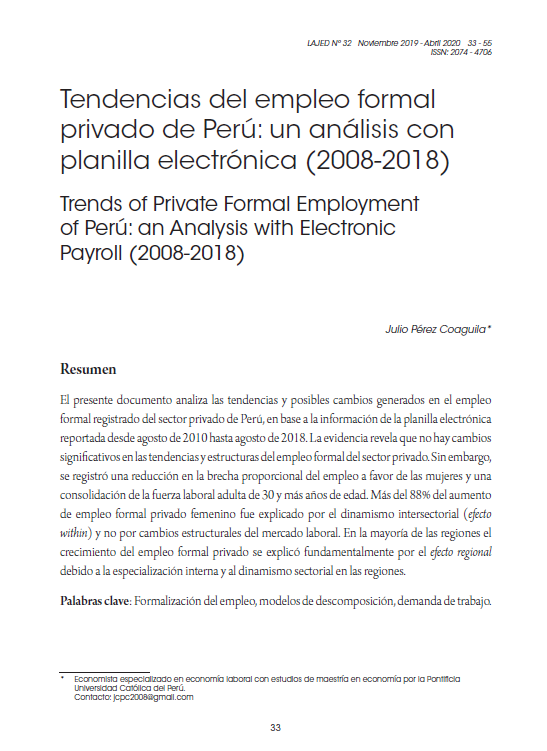Trends of Private Formal Employment of Perú: an Analysis with Electronic Payroll (2008-2018)
DOI:
https://doi.org/10.35319/lajed.201932398Keywords:
Formalization of employment, models of decomposition, demand for work.Abstract
This document analyzes the trends and possible changes generated in the registered formal employment of the private sector, based on the information from the electronic form reported from August 2010 to August 2018. The evidence reveals that there are no significant changes in the trends and formal employment structures of the private sector. However, there was a reduction in the proportional employment gap in favor of women and a consolidation of the adult labor force aged 30 and over. More than 88% of the increase in female private formal employment was explained by intersectoral dynamism (effect within) and not by structural changes in the labor market. In most regions, the growth of private formal employment was mainly explained by the regional effect due to internal specialization and sectoral dynamism in the regions.
Downloads
References
Arias, R. y Sánchez, L. (2013). “Análisis de la dinámica regional del empleo utilizando el modelo Shift Share espacialmente modificado en la Gran Área Metropolitana (GAM) de Costa Rica para el periodo 2000-2011”. Revista Ciencias Económicas 31(2), 135-156.
Banco Mundial (2008). Peru: Trajectories towards Formality. Report No. 43737-PE. Poverty Reduction and Economic Management Bolivia, Ecuador, Peru and Venezuela Country Management Unit Latin America and the Caribbean Region.
Chacaltana, J. (2016). “Perú, 2002-2012: crecimiento, cambio estructural y formalización”. Revista CEPAL. 119, 47-68.
Dinc, M., Haynes, K. y Qiangsheng, L. (1998). “A Comparative Evaluation of Shift-Share Models and Their Extensions”. Australasian Journal of Regional Studies, 4(2), 275-302.
Dunn, E. (1960). “A statistical and analytical technique for regional analysis”. Papers and Proceedings of the Regional Science Association. 6, 97-112.
Fernández, M. y Menéndez, A. (2005). “The spatial shift-share analysis – new developments and some findings for the Spanish case”. 45th Congress of the European Regional Science Association. European Regional Science Association (ERSA).
Gasparini, L. y Marchionni, M. (2015). Bridging gender gaps? The rise and deceleration of female labor force participation in Latin America. Buenos Aires: CEDLAS.
INEI (2018). "Producción y empleo informal en el Perú, Cuenta satélite de la economía informal 2007-2017". Instituto Nacional de Estadística e Informática, Perú.
Medina, F. y Galván, M. (2008). “Descomposición del coeficiente de Gini por fuentes de ingreso: evidencia empírica para América Latina, 1999-2005”. Serie Estudios Estadísticos y Prospectivos, N° 63, CEPAL.
MTPE (2018). "Informe anual del empleo 2017". Ministerio de Trabajo y Promoción del Empleo, Perú.
Nazara, S. y Hewings, G. (2004). “Spatial Structure and Taxonomy of Decomposition in shift-share analysis”. Growth and Change, 35 (4), 476-490.
OECD (2016). OECD Territorial Reviews: Peru 2016, OECD Publishing, Paris. Recuperado de https://doi.org/10.1787/9789264262904-en
Ruiz-Arranz, M. y Deza, M. C. (2018). “Creciendo con productividad. Una agenda para la región andina”. Banco Interamericano de Desarrollo.






